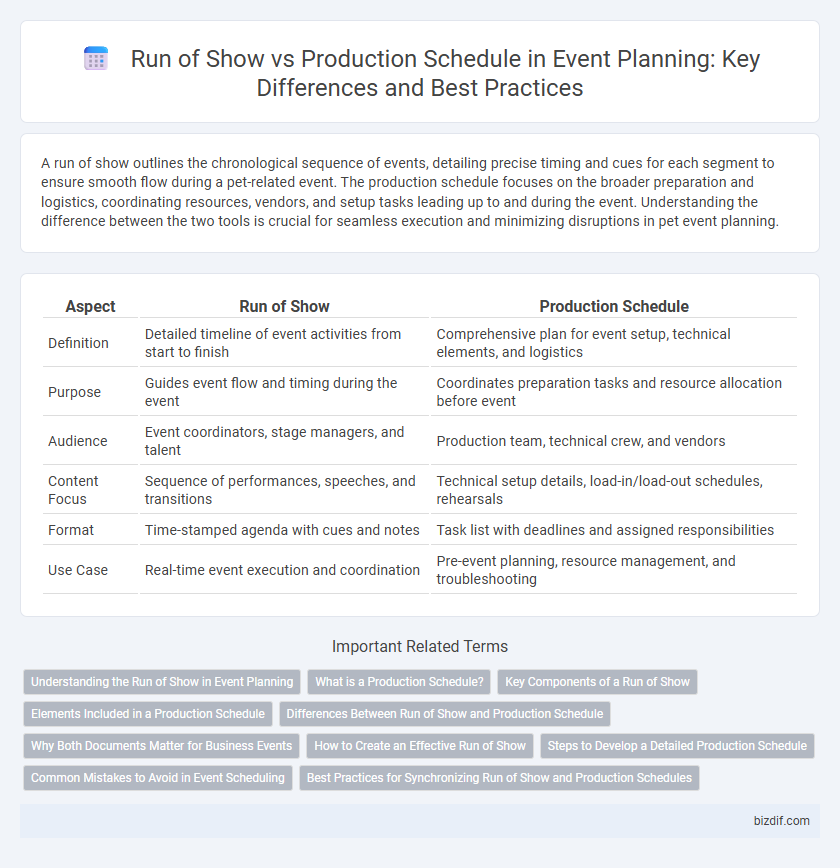A run of show outlines the chronological sequence of events, detailing precise timing and cues for each segment to ensure smooth flow during a pet-related event. The production schedule focuses on the broader preparation and logistics, coordinating resources, vendors, and setup tasks leading up to and during the event. Understanding the difference between the two tools is crucial for seamless execution and minimizing disruptions in pet event planning.
Table of Comparison
| Aspect | Run of Show | Production Schedule |
|---|---|---|
| Definition | Detailed timeline of event activities from start to finish | Comprehensive plan for event setup, technical elements, and logistics |
| Purpose | Guides event flow and timing during the event | Coordinates preparation tasks and resource allocation before event |
| Audience | Event coordinators, stage managers, and talent | Production team, technical crew, and vendors |
| Content Focus | Sequence of performances, speeches, and transitions | Technical setup details, load-in/load-out schedules, rehearsals |
| Format | Time-stamped agenda with cues and notes | Task list with deadlines and assigned responsibilities |
| Use Case | Real-time event execution and coordination | Pre-event planning, resource management, and troubleshooting |
Understanding the Run of Show in Event Planning
The Run of Show in event planning acts as a detailed timeline outlining every moment of the event, specifying who is responsible and when each segment occurs. It differs from the production schedule, which primarily focuses on the logistical and technical aspects behind the scenes, such as setup times and equipment management. Understanding the Run of Show ensures seamless coordination among presenters, performers, and staff, promoting a smooth and well-timed event experience.
What is a Production Schedule?
A production schedule is a detailed timeline outlining every task and milestone necessary to execute an event, ensuring all teams coordinate effectively to meet deadlines. It includes specific details such as setup times, technical rehearsals, equipment load-in, and cueing for lighting and sound. Unlike the run of show, which focuses on the event flow and timing, the production schedule emphasizes logistical planning and resource management for smooth event execution.
Key Components of a Run of Show
A Run of Show outlines the sequence and timing of all event activities, including speaker slots, performances, and transitions, to ensure smooth execution. Key components include detailed time stamps, assigned roles and responsibilities, cues for technical teams, and contingency plans for unexpected changes. Unlike a production schedule that focuses on logistical and setup tasks, the Run of Show emphasizes real-time event flow to maintain coordination among all participants.
Elements Included in a Production Schedule
A production schedule includes detailed elements such as timeline breakdowns, task assignments, technical setups, equipment lists, and contingency plans crucial for event execution. It outlines vendor arrival times, rehearsal slots, and cue sequences to ensure seamless coordination among staff and suppliers. This comprehensive document ensures all operational aspects align precisely with the event's objectives and timelines.
Differences Between Run of Show and Production Schedule
Run of show outlines a detailed, minute-by-minute timeline of an event's activities, focusing primarily on the flow and sequencing of each segment. Production schedule emphasizes logistical coordination, managing resources, equipment setup, and technical requirements to ensure smooth execution. The run of show guides on-stage actions, while the production schedule ensures behind-the-scenes readiness.
Why Both Documents Matter for Business Events
Run of show and production schedule are critical for seamless business event execution, each serving distinct purposes that ensure clarity and coordination. The run of show provides a minute-by-minute breakdown of the event flow, guiding hosts and speakers on timing and transitions, while the production schedule details technical and logistical tasks for crew and vendors. Using both documents enhances communication, reduces errors, and guarantees that strategic objectives and attendee experiences align perfectly.
How to Create an Effective Run of Show
Creating an effective run of show involves detailing every event moment with precise timing and assigned responsibilities, ensuring smooth transitions and clear communication among all team members. Incorporate key elements such as speaker cues, technical setups, and contingency plans to align with the production schedule's broader timeline. Utilize digital tools like event management software to update the run of show in real time, facilitating coordination between vendors, staff, and talent for flawless execution.
Steps to Develop a Detailed Production Schedule
Creating a detailed production schedule begins with defining every task from setup to teardown, assigning specific times and responsible team members to ensure seamless execution. Integrating the run of show, which outlines the event flow and key moments, helps align timing and resources efficiently across all production elements. Regular communication and updates are vital to accommodate changes and maintain synchronization between technical crews, performers, and event planners.
Common Mistakes to Avoid in Event Scheduling
Confusing the run of show with the production schedule often leads to misaligned timelines and resource conflicts, as the run of show details the event flow while the production schedule covers setup and technical logistics. Overloading the schedule with excessive buffer times causes inefficient use of resources and attendee frustration due to prolonged downtime. Failing to regularly update both documents results in communication breakdowns among teams, increasing the risk of delays and missed cues during the event.
Best Practices for Synchronizing Run of Show and Production Schedules
Aligning the run of show with the production schedule ensures seamless event execution by detailing precise timing and responsibilities for each segment. Best practices include regular cross-team communication, real-time updates via collaborative tools, and incorporating buffer times to adapt to unexpected changes. Synchronizing these documents enhances coordination among vendors, crew, and speakers, minimizing errors and optimizing event flow.
Run of show vs production schedule Infographic

 bizdif.com
bizdif.com